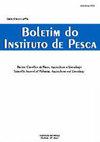EXTRACTION OF COLLAGENOLYTIC ENZYME FROM FISH VISCERA BY PHASE PARTITIONING (PEG/CITRATE) AND ITS POTENTIAL FOR INDUSTRIAL APPLICATION
IF 0.6
4区 农林科学
Q4 FISHERIES
引用次数: 1
Abstract
Internal viscera fish are potential sources of protein biomolecules of biopharmaceutical interest. However, this residue is frequently discarded inappropriately. The possibility to obtain byproducts of higher added value is a reality. Inside this view attention must be given to processes for the recovery and extraction of target molecules. However, the high cost of processing these residues is one of the obstacles to their reuse; techniques that facilitate their handling and make the process cheaper are desirable, such as extraction in a two-phase aqueous system. Thus, the aim of this study was to extract collagenolytic enzymes from common snook (Centropomus undecimalis) using a two-phase aqueous system (polyethylene glycol/citrate), according to the 24 factorial design, using as variables: molar mass of PEG (MPEG), PEG concentration (CPEG), citrate concentration (CCIT), pH, still, considering purification factor (FP), partition coefficient (K), and yield (Y). The collagenolytic activity of the crude extract was 102.41 U mg-1, after partitioning, was purified 3.91 times (MPEG: 8000; CPEG: 20.0%; CCIT: 20.0% and pH 6.0). Inhibition (U mg-1) was observed in benzamidine (22.51), TLCK (21.05), TPCK (21.29), and PMSF (23.05), signaling to be a serine-protease. The results showed the advantage of this semipurification technique as concerns to the low cost of extraction and purification, adding value to the fishing source material and allocating the residues from its processing to the industry.相分配法(聚乙二醇/柠檬酸盐)从鱼内脏中提取胶原溶解酶及其工业应用潜力
鱼类内脏是具有生物制药价值的蛋白质生物分子的潜在来源。然而,这些残留物经常被不恰当地丢弃。获得高附加值副产品的可能性是现实存在的。在这一观点中,必须注意目标分子的回收和提取过程。然而,处理这些残留物的高成本是其再利用的障碍之一;便于处理和使过程更便宜的技术是可取的,例如在两相水系统中提取。因此,本研究的目的是根据24因子设计,使用两相水体系(聚乙二醇/柠檬酸盐)从普通石竹(Centropomus decunimalis)中提取胶原溶解酶,以作为变量:PEG摩尔质量(MPEG)、PEG浓度(CPEG)、柠檬酸盐浓度(CCIT)、pH、still,综合考虑纯化因子(FP)、分割系数(K)和得率(Y)。粗提物的溶胶原活性为102.41 U mg-1,经分割后纯化3.91次(MPEG: 8000;CPEG: 20.0%;CCIT: 20.0%, pH 6.0)。在benzamidine (22.51), TLCK (21.05), TPCK(21.29)和PMSF(23.05)中观察到抑制(U mg-1),表明是丝氨酸蛋白酶。结果表明,这种半纯化技术的优势在于提取和纯化成本低,增加了捕捞源材料的价值,并将其加工后的残留物分配给工业。
本文章由计算机程序翻译,如有差异,请以英文原文为准。
求助全文
约1分钟内获得全文
求助全文
来源期刊

Boletim do Instituto de Pesca
FISHERIES-ZOOLOGY
CiteScore
0.80
自引率
0.00%
发文量
24
审稿时长
>12 weeks
期刊介绍:
To publish original articles of research and short communications in the following áreas: Fisheries, Aquaculture, Zootechnology, Limnology, Oceanography, Biology and Pathology of aquatic organisms. The publication depends on the approval of the Editorial Board, based on the peer review.
 求助内容:
求助内容: 应助结果提醒方式:
应助结果提醒方式:


